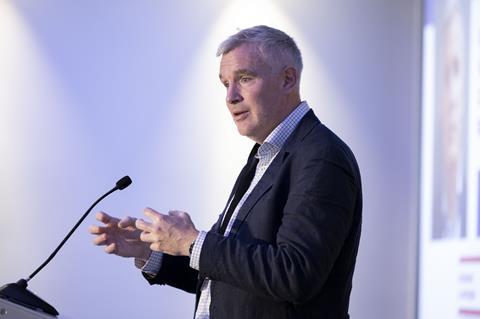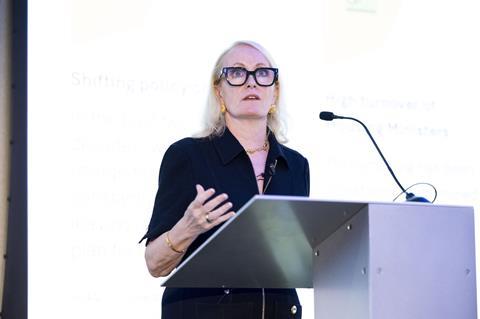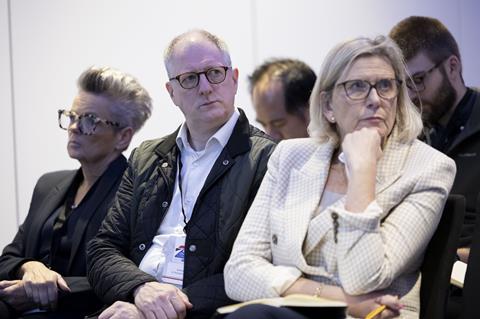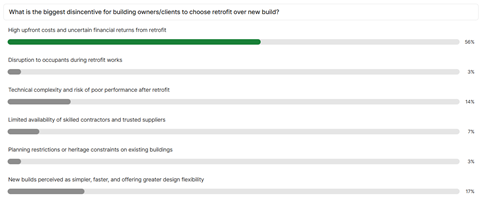Building’s flagship conference returned this year, bigger and better than ever, covering all things housing, infrastructure and development. From three keynotes and 10 panels, here are the main issues noted by our reporters

Around 600 professionals from across the built environment gathered together in the City of London yesterday (Thursday) to attend this year’s Building the Future Conference.
Three times bigger than last year, the event held at 155 Bishopsgate over a full day saw discussion of building safety, sustainability and funding, as well as fascinating keynotes from L&Q boss Fiona Fletcher Smith, CLC chief Mark Reynolds and the new chair of the Building Safety Regulator (BSR), Andy Roe.
Here is our round-up of the key issues and topics of discussion:
Tackling the building safety and competency challenge
Building safety and competence was top of the agenda, with the delays at gateway 2 being addressed in two keynote speeches that book-ended the conference. The day began with a stark and candid speech and Q&A with Andy Roe, chair of the Building Safety Regulator.
Reflecting on his experience at the Grenfell Tower tragedy, where he spoke of “counting the bodies out” and described the fire as “an apex failure”, Roe said the new building safety regime is “absolutely correct in principle” but in practice is not yet working. “Not building housing does not help keep people safe,” he warned.
Roe admitted that the greatest pain is experienced at gateway 2, where “in reality the 12-week SLA [service-level agreement] is not working” and is “not working economically”. There are 156 new-build applications now in the system, with those submitted under the new regime “progressing at pace”. But almost 100 applications lodged under the old system remain stuck. Roe said he hopes to clear them by the end of the year.
In recognition that the original system was not working, the BSR has made changes – and, as Roe put it, “now we have to see if the changes we’ve made will work”, with signs of “quicker rejections.”
On regulation, he was emphatic: “Don’t touch the second staircase rule. I think two staircases is […] completely acceptable.”
He also said he was “interested in implementing a pre-application process” – though “you’re not going to get that tomorrow” – and talked about taking the BSR out of the Health and Safety Executive (HSE) and improving access to the portals. He also set out a range of measures that he hoped would speed up approvals.
The pressure of delivery was clear in his final warning: “I need to make sure it works, otherwise I won’t be back here next year as the chair of the BSR.”
Roe was also present for a subsequent panel session on compliance, in which Rachel Davidson, director of specialist knowledge at BESA, said that the industry was calling for “simpler and more accessible guidance”, particularly to help SMEs. Roe agreed that current regulator guidance was not organised clearly, describing it as a “day one action” of a new single regulator to create “a singular identity expressed through a single point of entry with all of the guidance captured in one place”.
He said existing accreditation systems for competency in the industry were also confusing. “It doesn’t feel like there’s a single source of truth,” he said. “It doesn’t feel like there’s a single arbitrator, and it doesn’t feel like there’s a consistent methodology to judge what the benchmarks are.”

The day ended on a relatively positive note with an address from CLC co-chair Mark Reynolds, who said he was “confident” that, by the end of the year, the industry would “start to see a greater number of schemes being approved and we will begin to move to a steady state”.
He said the CLC’s building safety workstream had “brought about significant change within the BSR and assisted industry change through the fantastic competency work and guidelines”.
Reynolds admitted that “the past few years’ trading environment has not been easy” but urged delegates to “look at the positives”, pointing to the government’s “significant public sector investment plans”.
“Covid showed us that the construction industry works best as an ecosystem. If one part stops functioning or underperforms, everyone suffers. So, my advice is we need to be ready,” he said.
“We need to get fit for the opportunities that I believe we will begin to see in 2026 and which hopefully will last for the next 10 years.”
Will new regulations revolutionise product safety and traceability?
In the afternoon, a session on product safety saw Paul Morrell, former UK chief construction adviser and chair of the review of product testing systems, stress that no new regulations are yet in place for products or materials. He identified a central issue of whether the UK should align with EU standards, noting the political sensitivities whenever the EU is mentioned.
He questioned how the UK could toughen its system while recognising CE marking, asking: “Surely you can’t impose a harsher regulation on British manufacturing?” He also said he would have written a different review had he known that CE recognition was to continue.
Morrell said that EU standards were designed to facilitate trade rather than ensure safety, and suggested the UK could make more use of the Building Safety Act to limit the suitability of certain products for particular projects. He argued that greater responsibility could be placed on architects and contractors when specifying materials.

“If there’s anyone in the government who knows what safety is, I’ve not met them yet,” he remarked, while also floating the idea that voluntary standards could have a role.
Amanda Long, chief executive of the Code for Construction Product Information )CCPI), argued that “revolutionary change is needed”. She said that the culture of “build it fast and build it cheap” lay at the root of current problems, and emphasised the importance of considering products at the very start of projects.
While she supported voluntary standards, she said stronger incentives were needed to secure manufacturer engagement. She also pointed to low industry uptake of CCPI, adding: “We need to think about the responsibility that industry is still not taking.”
If there’s anyone in the government who knows what safety is, I’ve not met them yet
Paul Morrell, former UK chief construction adviser
Long noted that some responsibilities are already embedded in the Building Safety Act for high-risk buildings, giving industry scope to shape how these duties are to be applied.
Dr Andrew Taylor, head of technical at the Association for Specialist Fire Protection, said the industry remained in limbo while awaiting the government’s response to the green paper, expected in spring. “To answer the question depends what the regulation says and when we get it,” he commented, while continuing to press for mandatory measures.
Nigel Morrey, technical director at Etex Building Performance, noted that British Standards remain in force until September 2029, but said manufacturers are increasingly reliant on third-party verification. He called for clearer specifications, better education of specifiers on the use of classification reports, and for manufacturers to test products beyond the standards.
He also highlighted the importance of site presence, stressing manufacturers are also designers and “have to take on that responsibility”. He urged the creation of proper competency pathways for staff, adding: “These are all proactive things we can be doing.”
Meeting the challenge of 1.5m homes
While the BSR chief’s words will have been interesting to residential developers across the country, the new building safety regime is not the only challenge they face in trying to hit the government’s target of 1.5 million homes in this parliament.
In her own keynote, Fiona Fletcher Smith, group chief executive of L&Q, welcomed the government’s target as “incredibly positive,” but highlighted how environmental and net zero pressures “are not going away”. She also pointed to a legacy of “policy uncertainty for decades” and instability around rent policy, exacerbated by the “massive turnover in housing ministers”.
The wider context is stark: “The public sector is in decline,” she said, describing housing associations as “the last pub in the town”.

On section 106, she was clear that poor management arrangements put in place by housebuilders were a major block to housing associations taking on this stock. She described much of the management sector as “unregulated cowboys” – while noting some exceptions – and warned that, if these arrangements don’t improve, housing associations will simply not buy the homes.
The consequence, she added, is that fewer will be built. Her message to housebuilders was direct: engage early with housing associations if you want them to take your section 106 stock.
She argued that housing should be regarded as critical national infrastructure. But the UK’s fiscal rules, she said, are holding back progress: treating social housing investment as debt rather than as an asset is preventing the government from making the scale of investment needed.
She flagged the dramatic drop-off in housing delivery in London, and the deepening labour shortages, particularly in trades and professions. L&Q currently has only 60% of the roofers it needs in London, and is struggling to recruit skilled staff such as planners and surveyors.
“It will take seven years before these people are out of school and in the workforce,” she noted.
Yet, despite this backdrop, Fletcher-Smith struck an upbeat note. She welcomed the new 10-year social rent settlement, saying it provides the certainty housing associations need to plan. And, while the pressures are real, she ended on a positive note: “I remain optimistic.”
All of these policies are fantastic on their own, but collectively they don’t work together
Ashley Spearing, managing director of Berkeley Ventures
Later in the day, London’s plummeting number of housing starts formed the backdrop to a discussion on how to unlock housing delivery. The decline has been caused by a range of reasons, primarily the growing burden of regulatory barriers and the impact these are having on viability.
Pocket Living chief executive Paul Rickard said developers were simply being asked to do too much, describing the government’s treatment of the sector as “everythingism”. “I don’t think the system works,” he said.
“I think there’s a system in development that encourages this theory of everythingism. Historically, if there’s any problem, who can fix it? Put it on the developers.”
Ashley Spearing, managing director of Berkeley Ventures, highlighted the myriad approval stages needed before spades can be put in the ground on sites, from the formal planning process to discussions on section 106 agreements and, for the past two years, applications for gateway 2 approval under the new building safety regime which are needed before construction can start. “All of these policies are fantastic on their own, but collectively they don’t work together,” he said.

Spearing also spoke frankly about Berkeley’s experience in the modular sector, which has suffered a well-publicised collapse in recent years with the demise of several major off-site and modular firms, including the developer’s own venture. “It didn’t work,” Spearing said simply, admitting that the approach had proved more costly than traditional methods of construction.
On a separate panel, Jas Bhalla, principal at Jas Bhalla Works, argued that the new towns initiative must rethink its funding models to truly deliver.
He said that, while the new towns programme is a “really positive first step, it would be great to see us learning from some of the delivery mechanisms that work from earlier generations of postwar new towns piggybacking off public-private partnership to accelerate delivery”.
But, the panel agreed that building alone will not address the affordable housing shortage and a renewed focus on regeneration with sustainability in mind will help to deliver more homes faster that will serve the communities of the future.
Meanwhile, Miranda McLaren, director at Orms, said that around one in 10 housing schemes do not have an architect involved. Although she said architects “don’t need to be involved in everything”, certain projects should adhere to some design codes. She pointed out that the lack of standards for emergency temporary accommodation has led to the “tragic” death of “lots and lots” of babies.
Attracting and retaining the next generation
As ever, skills – and the shortage of them – remain one of the central talking points in the industry. So what does it mean to be a good employer, one that can both attract and retain high-calibre talent?
Amanda Whittington, principal at Ryder Architecture, described the government’s funding cuts to level 7 architecture apprenticeships as a “real blow” for the industry, prompting further discussion about how to combat a loss of diversity and young people.
Sarah Brown, UK people director at Gleeds, suggested that the ideal way for companies to build loyalty with young professionals and women is to provide them with opportunities to carry out “inspiring work”. She pointed out that “career progression, role identity and meaningful project work” are cited as major factors that can attract more women in particular to the industry.
Meanwhile, graduates are looking for clear routes up the career ladder, which is why McLaughlin & Harvey have a focus on bringing young people into the business by recruiting school leavers onto trainee schemes. According to the firm’s group HR director, Alison Reilly, around two and a half thousand candidates submitted applications for 12 trainee positions that were recently advertised.

The panel agreed that, while an increased emphasis on mental health support in the workplace – such as mental health first-aiders and on-site mental wellbeing champions – is important, so is teaching resilience to the up-and-coming workforce.
Whittington said the industry risks “exposing younger generations to much more stress and much more information than we did before” due to a digitalised work model that centres around Microsoft Teams. She advocates for managing this transition in a supportive way so the workforce of the future does not burn out early.
Navigating a volatile landscape on regulation and retrofit
How often do you get the housing ombudsman, CIH boss, directors at a housing association and Savills and a law firm partner all on a panel together? Well, it was this line-up in discussion that brought the conference to a close as they considered how to navigate an increasingly volatile regulatory landscape.
The panel underscored the need for comprehensive data collection on residents in order to cater for diverse demographics and achieve regulatory compliance.
Gavin Smart, chief executive of the CIH, said that AI will be helpful for filling in knowledge gaps caused by “differential non-response”, whereby certain categories of people systematically do not respond to surveys.
Picking up this point, Steve Partridge, director and head of housing consultancy at Savills, wondered how AI and digitalisation will impact employee performance in housing providers over the next decade, asking whether a knowledge of and understanding of AI could become a requisite for the job.
An earlier panel discussion also saw discussion of regulatory uncertainty; this one looking at retrofitting the UK’s housing stock came on the same day that the Conservative party vowed to repeal the Climate Change Act if it won power, the latest sign that opposition to net zero in politics is growing.
Kayla Friedman, Cambridge University course director for sustainability leadership in the built environment, admitted that the consensus over net zero did appear to be breaking down, arguing that sticking to carbon reduction targets was simply “business sense”.
Meanwhile, Ridge sustainability partner Phil Kelly said he wanted to counter a growing “not fabric first” narrative which argues in favour of installing heat pumps before fabric interventions such as insulation. “You have companies with a commercial interest who say fabric third, and I think that’s potentially irresponsible because consumers trust big brands, and where’s the voice of the industry saying you have to do fabric first? It’s economically inefficient not to.”
Looking to the future on funding and data centres
One of the afternoon sessions looked at how to find the money to rebuild Britain, reflecting the goals of Building’s Funding the Future campaign. Steve Beechey, group public sector director at Wates Group, said that public finance initiatives should not be used in the way they were under the Blair government.
“It [PFI] started getting used for all sorts of things,” he said. “That was where it all went wrong.”
He said that if the government wanted to relaunch PFI it would have to “rebuild trust”, with the new National Infrastructure and Service Transformation Authority given authority to lead the programme and given proper resources.
Beth West, formerly head of development at Landsec and chief executive of East West Rail, said there was “zero urgency” in this infrastructure programme and that “we need to get on with stuff”.
Another session in the afternoon also cast an eye to the future – looking at the potential boom in data centre development. With the highest energy costs in the developed world, the UK might seem like an unlikely market for famously energy-intensive datacentres. But with GDPR rules restricting how data can be used across borders and data-usage skyrocketing, appetite for the schemes in this country is booming.
How much growth there will be over the coming years is a matter of debate. “Some of the investment figures which are being bandied around the industry at the moment are quite frankly colossal,” said Ridge partner and project manager Rennie Dalrymple. While he said he would not go so far as to describe this as a “bubble”, he admitted “probably the reality is it will be slower”.
Meanwhile, those on the panel highlighted that many major schemes have been stalled over the past two years by government reforms to how the energy grid works, with work expected to start picking up early next year. Other challenges include the lack of a specific planning use for datacentres and local resistance to the buildings, which typically resemble giant sheds.
“Data centres are an uncomfortable fit in the planning process,” said Pure Data Centres Group chief architect Martin Wright, adding: “We haven’t seen the results yet of government rhetoric on making our lives easier.”
Audience participation
Throughout the day, audience members were encouraged to ask questions of the speakers. They were also asked to vote on key topics through interactive polls.
Delefates voted on various issues such as building safety delays, retrofit obstacles and how to meet new social housing consumer standards.
The bar charts below show the percentage voting for each option:





























No comments yet